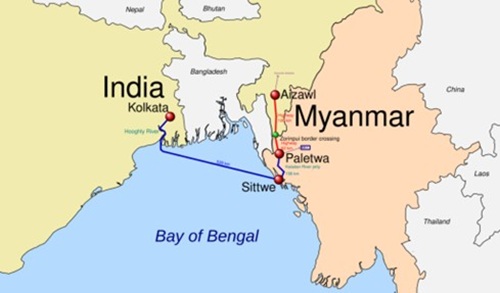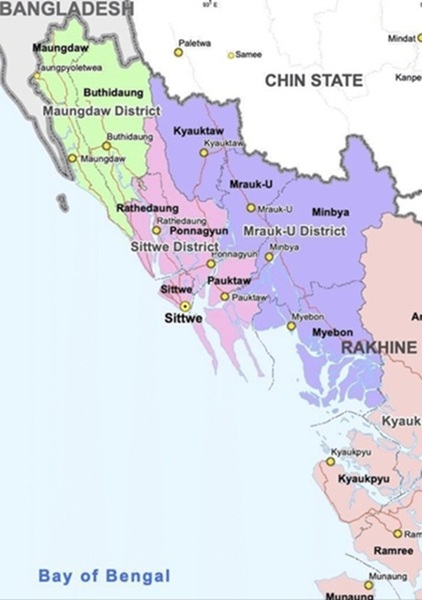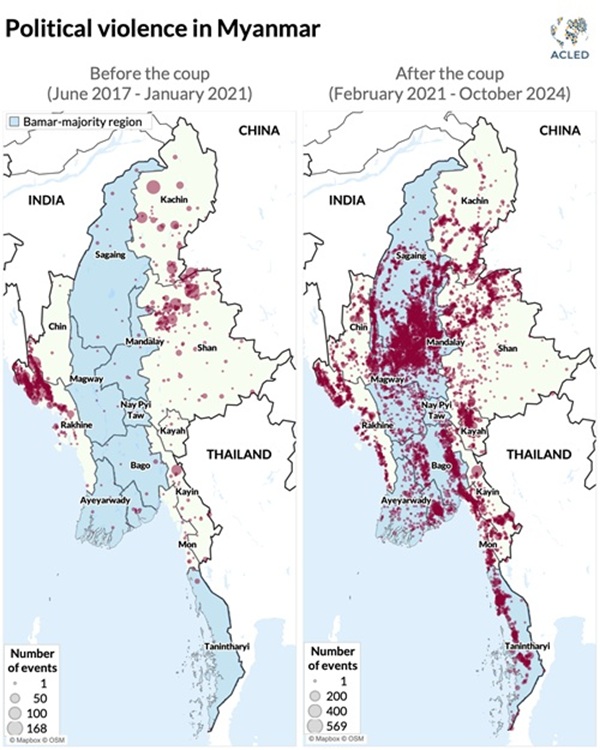On 9th Dec 2024, Arakan Army (AA), one of the most powerful Ethnic Armed Organisations and one from the Three Brotherhood Alliance (the other two being the MNDAA and TNLA) battling Myanmar Army (Tatmadaw) captured one of the last army outposts in the strategic western town of Maungdaw (see Map 2), gaining full control of the 271-kilometer (168-mile) long border with Bangladesh, thus making it the first full border of Myanmar with any country to fall. For the BGP-5 (Border Guard Police outpost No.5)), the end when it came, was loud and brutal. First, a crackly speaker calling out for their surrender; then, a thunderous barrage of artillery, rockets and rifle fire that tore chunks out of the buildings in which hundreds of soldiers were hiding. BGP-5 was the Myanmar military junta's last stand in northern Rakhine State, which lies along the border with Bangladesh. [1] Further, on 20th Dec 2024, the AA announced its capture of the regional army headquarters in Rakhine state, marking a significant victory in its ongoing fight against the junta. [2] The headquarters’ Deputy Commander, Brig. Gen. Thaung Tun and it’s Chief Operating Officer, Brig. Gen. Kyaw Kyaw Than, were amongst those who were taken prisoners. Earlier, in August, the MNDAA, had seized control of the regional command headquarters in Lashio in the North-East. This news in the Indian media went largely unnoticed despite it having far reaching implications for the future. Myanmar is the only country that sits at the intersection of India’s “Neighbourhood First” policy as also “Act East” policy. And in Myanmar, for overcoming the Siliguri corridor’s long connectivity issues, it is the state of Rakhine through which the $ 484 (Rs 4,904 crores) Kaladan Multi-Modal Trade and Transit Project (KMTTP, Map 1) passes which offers suitable connectivity.

This victory of the AA in Rakhine is the culmination of a decade of struggle to carve an independent State out of Myanmar. The group’s raising (it was founded in Laiza, Kachin State on April 10, 2009) was facilitated by the Kachin Independence Army (KIA) on the Chinese border and it began fighting the Myanmar Army (Tatmadaw) in support of the KIA after fighting broke out in Kachin State with the Tatmadaw in June 2011. The AA's ideology is Arakan self-determination. With the entire state of Rakhine now virtually under its control, it is on the verge of realising its long-cherished dream of a self-governing Arakan Region. This liberation aims to restore the sovereignty that was lost when he Burman kingdom conquered the Arakanese capital in the late 18th century. [3]
The AA is the military wing of the Buddhist Rakhine ethnic group in Rakhine state, where they are the majority and before Maungdaw, it had captured Paletwa and Buthidaung (Map 2), two other towns on the border with Bangladesh. Paletwa is the last township in Myanmar before the KMTTP road connects up with Zorinpui, the township on the Indian side in Mizoram. Rakhine state does not border India, but the key port (Sittwe) and road (Sittwe-Paletwa) of the KMTTP that are so significant for its success, pass through Rakhine.
At the heart of KMTTP lies the deep seaport of Sittwe (refer map), which would ensure maritime connectivity from Kolkata, the Kaladan River (providing the internal waterway) that flows from Mizoram into the Sittwe port in Rakhine and the 109 kms of road from Paletwa to Zorinpui in Mizoram. The project will also make it easier for citizens of both countries to travel by road for education, medical assistance, tourism, and other purposes. The significance of the KMTTP is not just for India, but also for Myanmar (Rakhine particularly), hence needs to be understood. For India, it lies in the fact that by overcoming the Siliguri dilemma of the Northeast, it would ensure better connectivity, cut transportation costs, speed up development and ensure that the Northeast is no more a laggard in the overall rise of India. The waterways section was completed at a cost of Rs 982.99 crores. However, the road link connecting Mizoram to the Sittwe seaport remains unfinished. According to the latest statement from the MEA, earthwork has been completed on 20 kilometres of the 109.2-kilometre road link. As of November 2024, India has spent Rs 356 crores on this stretch. The latest deadline for its completion is July 2025.[4] Five firms in Myanmar, including one affiliated to the government, have set up a consortium to build the 109 kms highway. The consortium has signed an agreement with the Indian Railway Construction Company (IRCON), which bagged the contract from the Indian government nearly two years ago. [5] The expenditure incurred on the KMTTP project would be in the form of grants as per a statement from the MEA on 20th Dec 2024. [6]
It is also the case that Rakhine State, Chin State and Sagaing regions (Chin borders Mizoram and Manipur and Sagaing borders Manipur and Nagaland) are today respectively under the control of the AA, Chin National Front-People Defence Force (CNF-PDF) and Pepole’s Defence Force (PDF) respectively. The CNF controls 70% of Chin State as per CNF spokesman Salai Htet Ni. [7] Sagaing region continues to witness multiple battles between the PDF and the Tatmadav. The AA and CNF both are Ethnic Armed Organisations looking for secession from Myanmar while the PDF is part of the National Unity Government (NUG), seeking restoration of democracy in Myanmar. To quote the vision of the AA, “Unity is the priority of priorities to Arakanese. Our greatest responsibility today is to prove our courage of unity refusing to live under the brutal and repressive dictatorship (read Junta) that had been destroying lives and resources of our land. It’s our nation’s right to live in freedom, democracy and a good decent life. We, the Arakan Army decisively hold the vision on uniting path of freedom, and we will pay the price for the best of tomorrows”. [8] The AA had launched its offensive in September this year to capture Ann, a township, about 400 kms North-West of Yangon. The AA now has control over 13 out of the 17 townships of Rakhine, besides one in the neighbouring Chin state. It is just a matter of time before the entire state of Rakhine now falls under the control of the AA.
Last year the AA had said that it would not disturb the construction of the road section of the KMTTP. It had assured India that it was not against the project, but only wanted to protect the interests of the local people. Rakhine is amongst the least developed states of Myanmar with no significant commercial port or good road connectivity. Thus, for the people of Rakhine, a state that has been neglected for long, the KMTTP would mean better and speedier development. This project could also herald the development of the Chin state and to some extent Sagaing region, which are also amongst the most underdeveloped regions of Myanmar. The development would be by virtue of goods and services reaching these regions both from the bustling port of Kolkata as also from the Northeast states. “The southern Chin state is among the most neglected regions in Myanmar and travelling from Zorinpui to Paletwa is possible only by river. The completion of the Kaladan project will mean motorable highways in the region and faster movement of goods and people,” said a middle-ranking officer of the Arakan Army. [9]
Before the 01 Feb 2021 coup by the Senior General Min Aung Hlaing, the areas bordering India in the Sagaing region and Chin state were considered very peaceful. In fact, Myanmar has always considered the Indian border to be the most peaceful when compared with the borders that it shares with its other neighbours. The other neighbouring borders include those with China, Laos, Thailand which have traditionally been disturbed due to ethnic insurgencies and the Bangladesh border, which has witnessed the violent trans-border movement of the Rohingya refugees in the past. The Chinese border has been the most troublesome with the United Wa State Army, MNDAA, TNLA and KIA fighters exercising almost total control in their respective areas, besides being supported tacitly by the Chinese. The borders with Thailand and Laos also include the Golden Triangle, where in the past two years poppy cultivation has increased exponentially. China, with significant economic interests and investments in these regions, views Shan and Rakhine states as crucial to its strategic and economic plans, particularly through the China-Myanmar Economic Corridor (CMEC), part of the Belt and Road Initiative (BRI). [10]


China sees India’s Act East Policy and in it the major KMTTP project as a project that clashes with its strategic and economic interests, particularly so because Sittwe and Kyaukphyu, both are in Rakhine. China would thus continue to attempt to delay or scuttle the KMTTP, which could well be by using the AA as a proxy. The need for speeding up the road part of the KMTTP therefore doesn’t have to be overstated. It is also necessary to know the distance and the condition of the road on the Indian side, that is, in Mizoram (the stretch beyond where the KMTTP culminates at Zorinpui in Mizoram). The distance from Zorinpui to the district headquarters of Lawngtlai is 87 kilometres. From there to the capital, Aizwal is 250 kilometres. This 337 kilometres stretch needs an upgrade in terms of the road condition and its width from its present condition. From Aizawl, the highway goes Northwards to Silchar, which is the start point for the East-West corridor to Porbandar, Gujarat.
Stability in Rakhine state is also significant for Bangladesh. The importance of Rakhine for Bangladesh stems from the fact that it is the only state of Myanmar that shares a boundary with Bangladesh (270 kms border, which constitutes 3.5% of the land border of Bangladesh, the rest 4,096 kms, which is 96.5% of Bangladesh’s land border being with India). Earlier, the Bangladesh- Myanmar border was in the news when over 7,00,000 Rohingya refugees from Rakhine crossed the Naf River (boundary between the two countries) in 2017 when there was a violent drive by the Tatmadaw to evict them from Myanmar. Today there are about a million Rohingya refugees in Cox’s Bazaar, Bangladesh and armed groups like the Arakan Rohingya Salvation Army (ARSA) and Rohingya Solidarity Organisation (RSO) with Pakistani connections wield a major influence in these camps. [11] Lately it has been reported that fighters from ARSA have joined the Tatmadaw to fight the AA (a strange case of the persecuted having joined hands with the persecutors). Now that the Tatmadaw has lost ground in Rakhine, there is every likelihood of the AA indulging in violence against the 70,000 Rohingyas who still remain in Rakhine. Further, the fall of the regional headquarters of the Tatmadaw in Sittwe will surely be contested and there would be a fightback by the Tatmadaw, which may even be with the Chinese help given that their deep seaport at Kyaukphyu in Rakhine has such great strategic and commercial significance.
All this does not augur well for India. The $ 484 investment in KMTTP should be seen in the light of how significant it is for India. Thus, there is a necessity to constantly engage with all stake holders not just in Myanmar (the Junta, AA and PDF) but also those in the region. Hence the recent visit by the Foreign Secretary, Vikram Misri to take part in a meeting hosted by Thailand in Bangkok that included Myanmar’s neighbours China, Bangladesh, Lao PDR, and a Junta government representative, is a step in the right direction. Incidentally, at the same venue, Thailand also hosted a separate discussion of ASEAN members on the implementation of the ‘five-point’ consensus’ which has not made any progress till now.
The turmoil in Manipur and the concurrent fighting in Chin and Sagaing has acted as a double whammy for our Act East outreach. If Myanmar is our land-bridge to Southeast Asia, Manipur is the fulcrum for it to fructify. The lay of the terrain and the centuries of people to people connect between Myanmar and Manipur, make Manipur the most important of the four states that border Myanmar. As important for us is the KMTTP; for India’s aim of turning into a $ 10 trillion economy in less than eight years’ time as also for our Viksit Bharat objective, the Northeast will have a very significant role to play.
References
[1] Jonathan Head and BBC Burmese, BBC News, 13 Dec 24
[2] The WIRE Staff, 21st Dec 2024 https://thewire.in/diplomacy/arakan-army-junta-rakhine-india
[3] International Crisis Group https://www.crisisgroup.org/asia/south-east-asia/myanmar/339-breaking-away-battle-myanmars-rakhine-state
[4] The WIRE Staff, 21st Dec 2024 https://thewire.in/diplomacy/arakan-army-junta-rakhine-india
[5] The Week, India-Myanmar: Why Kaladan transit project could resume soon, Rajeev Bhattacharya, 01 Dec 24
[6] The Hindustan Times, 20th Dec 2024, https://www.hindustantimes.com/india-news/watching-developments-in-myanmar-says-india-as-rebels-capture-military-command-101734701373017.html
[7] The Irrawaddy, 8th Sept 2024
[8] Official website of Arakkan Army https://www.arakanarmy.net/about-us
[9] The Week, India-Myanmar: Why Kaladan transit project could resume soon, Rajeev Bhattacharya, 01 Dec 24
[10] Special Eurasia, https://www.specialeurasia.com/2024/07/04/myanmar-war-chinas-ethnicmilitia/
[11] Reuters 25 Nov 2024, https://www.reuters.com/world/asia-pacific/worlds-largest-refugee-camps-rohingya-mobilise-fight-myanmar-2024-11-25/
(The paper is the author’s individual scholastic articulation. The author certifies that the article/paper is original in content, unpublished and it has not been submitted for publication/web upload elsewhere, and that the facts and figures quoted are duly referenced, as needed, and are believed to be correct). (The paper does not necessarily represent the organisational stance... More >>
Image Source: https://www.arakanarmy.net/post/%E1%80%9E%E1%80%90%E1%80%84-%E1%80%93-%E1%80%90-%E1%80%95-12











Post new comment